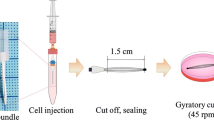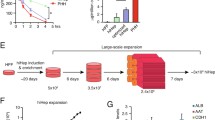Abstract
The clinical use of a bioartificial liver (BAL) device strongly depends on the development of human liver cell lines. The aim of this study was to establish and assess the potential use of the stable HepG2 cell line expressing human augmenter of liver regeneration (hALR). The cDNA encoding hALR protein was inserted into pcDNA3.1 to generate pcDNA3.1/hALR, following which pcDNA3.1/hALR was transfected to HepG2 to establish a cell line that stably expressed hALR (HepG2 hALR). A total of 800 million HepG2 hALR cells were loaded into laboratory-scale BAL bioreactors and cultured for 4 days, during which time the parameters of hepatocyte-specific function and general metabolism were determined. The cell line that stably expressed human ALR was successfully established. The expression of recombinant hALR was higher in the HepG2 hALR cell line than in the HepG2 cell line based on immunofluorescence and immunoblot assays. In samples removed from the BAL bioreactor on day 4, compared to HepG2 cells, HepG2 hALR cells produced significantly more alpha-fetoprotein (127.3 %; P < 0.05) and urea (128.8 %; P < 0.05) and eliminated more glucose (135.7 %; P < 0.05); the level of human albumin was also higher (117 %) in HepG2 hALR cells, but the difference was not significant (P > 0.05). After 24 h of culture, the mean lidocaine removal rate was 65.1 and 57.3 % in culture supernatants of HepG2 hALR and HepG2 cell lines, respectively (P < 0.01). Based on these results, we conclude that HepG2 hALR cells showed liver-specific functionality when cultured inside the bioreactor and would therefore be a potential cell source for BAL.




Similar content being viewed by others
References
O’Grady JG. Acute liver failure. Postgrad Med J. 2005;81:148–54.
Leckie P, Davenport A, Jalan R. Extracorporeal liver support. Blood Purif. 2012;34:158–63.
Mckenzie TJ, Lillegard JB, Nyberg SL. Artificial and bioaritificial liver support. Semin Liver Dis. 2008;28:210–7.
Van de Kerkhove MP, Hoekstra R, Chamuleau R, et al. Clinical application of bioartificial liver support systems. Ann Surg. 2004;240:216–30.
Duan ZP, Zhang J, Xin SJ, et al. Interim results of randomized controlled trial of ELAD in acute on chronic liver disease. Hepatology. 2007; AASLD Abstracts: 274A.
Ilowski M, Putz C, Weiss TS, et al. Augmenter of liver regeneration causes different kinetics of ERK1/2 and Akt/PKB phosphorylation than EGF and induces hepatocyte proliferation in an EGF receptor independent and liver specific manner. Biochem Biophys Res Commun. 2010;394:915–20.
Hayiya M, Francavilla A, Plimeno L, et al. Cloning and sequence analysis of the rat augmenter of liver regeneration (ALR) gene: expression of biologically active recombination ALR and demonstration of tissue distribution. Proc Natl Acad Sci USA. 1994;91:8142–6.
Thirunavukkarasu C, Wang LF, Harvey SA, et al. Augmenter of liver regeneration: an important intracellular survival factor for hepatocytes. J Hepatol. 2008;48:578–58.
Enosawa S, Miyashita T, Endo M, et al. Off-line bioartificial liver: a novel concept of treatment and its potency of liver regeneration. Transplant Proc. 2002;34:2711–3.
Yany X, Wang A, Zhou P, et al. Protective effect of recombinant human augmenter of liver regeneration on CCl4-induced hepatitis in mice. Chin Med J (Engl). 1998;111(7):625–9.
Poyck PP, van Wijk AC, van der Hoeven TV, et al. Evaluation of a new immortalized human fetal liver cell line (cBAL111) for application in bioartificial liver. J Hepatol. 2008;48:266–75.
Phua J, Lee KH. Liver support devices. Current Opinion in Critical Care. 2008;14:208–15.
Van de Kerkhove MP, Di Florio E, Scuderi V, et al. Phase I clinical trial with the AMC-bioartificial liver. Int J Artif Organs. 2002;25:950–9.
Lee K, Mun CH, Min BG. Development of a multifunctional detoxifying unit for liver failure patients. Blood Purif. 2012;34:225–30.
Hoekstra R, Nibourg GA, Hoeven TV, et al. The effect of rat acute-liver-failure plasma on HepaRG cells. Int J Artif Organs. 2012;35(11):1006–14.
Kataoka K, Nagaoa Y, Nuku T, et al. An organic–inorganic hybrid scaffold for the culture of HepG2 cells in a bioreactor. Biomaterials. 2005;26:2509–16.
Enosawa S, Miyashita T, Fujita Y, et al. In vivo estimation of bioartificial liver with recombinant HepG2 cells using pigs with ischemic liver failure. Cell Transplant. 2001;10:429–33.
Rai R, Flecknell P, Richardson C, Manas DM. Creation of porcine liver tumor using hepatoma cell lines. Cancer Biol Ther. 2005;4(6):635–7.
Pawlowski R, Jura J. ALR and liver regeneration. Mol Cell Biochem. 2006;288:159–69.
Vodovotz Y, Prelich J, Lagoa C, et al. Augmenter of liver regeneration (ALR) is a novel biomarker of hepatocellular stress/inflammation: in vitro, in vivo, and In silico studies. Mol Med. 2013;22(18):1421–9.
Li Y, Farooq M, Sheng D, et al. Augmenter of liver regeneration (ALR) promotes liver outgrowth during zebrafish hepatogenesis. PLoS ONE. 2012;7(1):e30835.
Dayoub R, Wagner H, Bataille F, et al. Liver regeneration associated protein (ALR) exhibits antimetastatic potential in hepatocellular carcinoma. Mol Med. 2011;17:221–8.
Rong YH, Liu HL, You SL, et al. Construction and experimental study on off-line hybrid bioartificial liver supporting system with human liver cell line. Zhonghua Shi Yan He Lin Chuang Bing Du Xue Za Zhi. 2010;24(3):193–5.
Hoekstra R, Nibourg GA, van der Hoeven TV, et al. Substantial phase 1 and phase 2 drug metabolism and bile acid production of HepaRG cells in a bioartificial liver in absence of dimethyl sulfoxide. Drug Metab Dispos. 2013;41:562–7.
Shulman M, Nahmias Y. Long-term culture and coculture of primary rat and human hepatocytes. Methods Mol Biol. 2013;945:287–302.
Acknowledgments
We thank the 12th Five-Year National Science and Technology Major Project for Infectious Diseases (No. 2012ZX10002004-005) for support.
Author information
Authors and Affiliations
Corresponding authors
Rights and permissions
About this article
Cite this article
Liu, H., You, S., Rong, Y. et al. The newly established human liver cell line: a potential cell source for the bioartificial liver in the future. Human Cell 26, 155–161 (2013). https://doi.org/10.1007/s13577-013-0068-5
Received:
Accepted:
Published:
Issue Date:
DOI: https://doi.org/10.1007/s13577-013-0068-5




